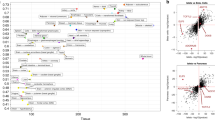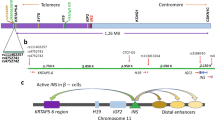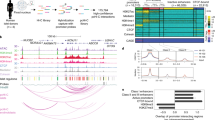Abstract
Genetic susceptibility to insulin–dependent diabetes mellitus (IDDM) is inherited as a polygenic trait. One of the loci implicated in IDDM is a polymorphic minisatellite 5′ of the human insulin (INS) gene on chromosome 11. This insulin–linked polymorphic region (ILPR) is composed of tandemly repeated sequences, which fall into three size classes: IDDM is strongly associated with short ILPR alleles. We now show that the ILPR is capable of transducing a transcriptional signal in pancreatic β–cells, with a long ILPR possessing greater activity than a short ILPR. The ILPR contains numerous high–affinity binding sites for the transcription factor Pur–1, and transcriptional activation by Pur–1 is modulated by naturally occurring sequences in the ILPR. Our results demonstrate a possible function for this unique minisatellite, which may have implications for type 1 diabetes.
This is a preview of subscription content, access via your institution
Access options
Subscribe to this journal
Receive 12 print issues and online access
$209.00 per year
only $17.42 per issue
Buy this article
- Purchase on Springer Link
- Instant access to full article PDF
Prices may be subject to local taxes which are calculated during checkout
Similar content being viewed by others

References
Tautz, D. Notes on the definition and nomenclature of tandemly repetitive DNA sequences. EXS 87, 21–28 (1993).
Collick, A. & Dunn, M.G. Minisatellite binding protein Msbp-1 isasequence-spedfic single-stranded DMA-binding protein. Nucleic Acids Res. 19, 6399–6404 (1991).
Wahls, W.P., Swenson, G. & Moore, P.D. Two hyper variable minisatellite DNA binding proteins. Nucleic Acids Res. 19, 3269–3274 (1991).
Yamazaki, H., Nomoto, S., Mishima, Y. & Komlnami, R. A 35-kDa protein binding to a cytosine-rich strand of hypervariable minisatellite DNA. J. Biol. Chem. 267, 12311–12316 (1992).
Trepicchio, W.L. & Krontiris, T.G. Members of the rel/NF-kB family of transcripttonal regulatory proteins bind the HRAS1 minisatellite DNA sequence. Nucl. Adds Res. 20, 2427–2434 (1992).
Wahls, W.P., Wallace, L.J. & Moore, P.D. Hypervariable minisatellite DNA is a hotspot for homologous recombination in human cells. Cell 60, 95–103 (1990).
Maddox, J. Triplet repeat genes raise questions. Nature 368, 685 (1994).
Davies, K. Triplet repeats on the rise. Nature 384, 88 (1993).
Bell, G.I., Selby, M. & Putter, W.J. The highly polymorphic region near the human insulin gene Is composed of simple tandemly repeating sequences. Nature 296, 31–35 (1982).
Bell, G.I., Karam, J.H. & Rutter, W.J. Polymorphic DNA region adjacent to the 5′ end of the human insulin gene. Pmc. rain. Acad. Sci. U.S.A. 78, 5759–5763 (1981).
Selno, S., Bell, G.I. & Li, W.H. Sequences of primate insulin genes support the hypothesis of a slower rate of molecular evolution in humans and apes than in monkeys. Molec. Biol. Evol. 9, 193–203 (1992).
Owerbach, D. & Aagaard, L. Analysis of a 1963-bp polymorphic region flanking the human Insulin gene. Gene 32, 475–479 (1984).
Rotwein, P., Yokoyama, S., Didier, D.K. & Chirgwin, J.M. Genetic analysis of the hypervariable region flanking the human insulin gene. Am. J. hum. Genet. 39, 291–299 (1986).
Walker, M.D., Edlund, T., Boulet, A.M. & Rutter, W.J. Cell-specific expression controlled by the 5′ flanking regions of the insulin and chymotrypsin genes. Nature 308, 557–581 (1983).
Bell, G.I., Horita, S. & Karam, J.H. A polymorphic locus near the human Insulin gene is associated with Insulin-dependent diabetes mellitus. Diabetes 33, 176–183 (1984).
Juller, C. et al. Insulin-IGF2 region on chromosome 11p encodes a gene Implicated in HLA-DR4-dependent diabetes susceptibility. Nature 354, 155–159 (1991).
Bain, S.C. et al. Insulin gene region-encoded susceptibility to type I diabetes Is not restricted to HLA-DR4-posttive individuals. Nature Genet. 2, 212–215 (1992).
Owerbach, D. & Gabbay, K.H. Localization of a type I diabetes susceptibility locus to the variable tandem repeat region flanking the insulin gene. Diabetes 42, 1708–1714 (1993).
Lucassen, A.M. et al. Susceptibility to Insulin dependent diabetes mellltus maps to a 4. 1 kb segment of DNA spanning the insulin gene and associated VNTR. Nature Genet. 4, 305–310 (1993).
Davies, J.L. et al. A genome-wide search for human type 1 diabetes susceptibility genes. Nature 371, 130–136 (1994).
Thomson, G. et at Genetic heterogeneity, modes of inheritance and risk estimates for a joint study of Caucasians with Insulin-dependent diabetes mellttus. Am. J. hum. Genet. 43, 799–816 (1988).
Platz, P. et al. HLA-D and HLA-DR antigens in genetic analysis of insulin-dependent diabetes mellitus. Oiabetologia 21, 108–115 (1981).
Owerbach, D. et al. HLA-D region B chain DNA endonuclease fragments differ between HLA-DR identical healthy and insulin-dependent diabetic individuals. Nature 303, 815–817 (1983).
Todd, J.A., Bell, J.I. & McDevttt, H.O. HLA-DQB gene contributes to susceptibility and resistance to insulin-dependent diabetes mellitus. Nature 329, 599–604 (1987).
Owerbach, D., Gunn, S., Ty, G., Wible, L. & Gabbay, K.H. Oligonucleotlde probes for HLA-DQA and HLA-DQB genes define susceptibility to type 1 (insulin-dependent) diabetes mellitus. Diabetotogia 31, 751–757 (1988).
Sheehy, M.J. et al. A diabetes-susceptibility HLA haplotype Is best defined by a combination of HLA-DR and HLA-DQ alleles. J. clln. Invest. 83, 830–835 (1989).
Owerbach, D., Gunn, S. & Gabbay, K.H. Primary association of HLA-DQw6 with type I diabetes mellltus In DR4 patients. Diabetes 38, 942–845 (1989).
Madsen, O. et al. Islet amyloid polypeptide and insulin expression are controlled differently in primary and transformed islet ceils. Motec. Endocrin. 5, 143–148 (1991).
Kennedy, G.C. & Rutter, W.J., Pur-1, a zinc-finger protein that binds to purlne-rich sequences, transactivates an insulin promoter In heterologous cells. Proc. natn. Acad. Scl. U.S.A. 89, 11498–11502 (1992).
Kennedy, G.C. & Rutter, W.J. Characterization of a cDNA encoding the insulin gene GAGA-bindcng factor, Pur-1. Biochem. Soc. Trans. 21, 178–180 (1993).
Singh, H., LeBowitz, J.H., Baldwin, A.S. & Sharp, P.A. Molecular cloning of an enhancer binding protein: Isolation by screening of an expression library with a recognition site DNA. Cell 52, 415–423 (1988).
Wang, Y.-H., Amlrhaeri, S., Kang, S., Wells, R.D. & Griffith, J.D. Preferential nucleosome assembly at DNA triplet repeats from the myotonic dystrophy gene. Science 285, 669–671 (1994).
Hammond-Kosack, M.C.U., Dobrinskl, B., Lurz, R., Docherty, K. & Kilpatrick, M. The human insulin gene linked polymorphic region exhibits an altered DNA structure. Nucl. Acids Res. 20, 231–236 (1992).
Hammond-Kosack, M.C.U. & Docherty, K. A consensus repeat sequence from the human insulin gene linked polymorphic region adopts multiple quadriplex DNA structures In vitro. FEBS Letts. 301, 79–82 (1992b).
Hammond-Kosack, M.C.U., Kilpatrick, M.W. & Docherty, K. The human Insulin gene-linked polymorphic region adopts a G-quartet structure in chromatln assembled in vitro. J. motec. Endocrin. 10, 121–126 (1993).
Lander, E.S. & Schork, N.J. Genetic dissection of complex traits Science 285, 2037–2048 (1994).
German, M.S., Moss, L.G. & Rutter, W.J. Regulation of insulin gene expression by glucose and calcium in transfected primary Islet cultures. J. biol. Chem. 265, 22063–22066 (1990).
Author information
Authors and Affiliations
Rights and permissions
About this article
Cite this article
Kennedy, G., German, M. & Rutter, W. The minisatellite in the diabetes susceptibility locus IDDM2 regulates insulin transcription. Nat Genet 9, 293–298 (1995). https://doi.org/10.1038/ng0395-293
Received:
Accepted:
Issue Date:
DOI: https://doi.org/10.1038/ng0395-293
This article is cited by
-
Association of tyrosine hydroxylase 01 (TH01) microsatellite and insulin gene (INS) variable number of tandem repeat (VNTR) with type 2 diabetes and fasting insulin secretion in Mexican population
Journal of Endocrinological Investigation (2023)
-
High-throughput techniques enable advances in the roles of DNA and RNA secondary structures in transcriptional and post-transcriptional gene regulation
Genome Biology (2022)
-
Large parental differences in chromatin organization in pancreatic beta cell line explaining diabetes susceptibility effects
Nature Communications (2021)
-
The association of insertions/deletions (INDELs) and variable number tandem repeats (VNTRs) with obesity and its related traits and complications
Journal of Physiological Anthropology (2017)
-
Investigation of coordination and order in transcription regulation of innate and adaptive immunity genes in type 1 diabetes
BMC Medical Genomics (2017)


